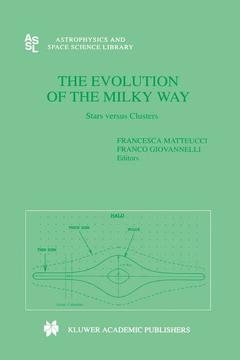Description
The Evolution of The Milky Way, 2000
Astrophysics and Space Science Library Series, Vol. 255
Coordinators: Matteucci Francesca, Giovannelli Franco
Language: English
Subject for The Evolution of The Milky Way:
Keywords
Bulge; Galaxy; Supernova; galaxies; interstellar matter; milky way; stars; stellar; stellar evolution
The Evolution of The Milky Way
Publication date: 11-2012
624 p. · 16x24 cm · Paperback
Publication date: 11-2012
624 p. · 16x24 cm · Paperback
The evolution of the milky way
Publication date: 01-2001
624 p. · 15.5x23.5 cm · Hardback
Publication date: 01-2001
624 p. · 15.5x23.5 cm · Hardback
Description
/li>Contents
/li>
This review of the most up-to-date observational and theoretical information concerning the chemical evolution of the Milky Way compares the abundances derived from field stars and clusters, giving information on the abundances and dynamics of gas.
The Chemical Evolution of the Milky Way: Some Important Facts.- S/¦Á/Fe Abundance Ratios in Galactic Metal Poor Stars.- S/?/Abundance Ratios in Halo Field Stars: is there a Globular Cluster Connection?.- Early Galactic Evolution of Carbon, Nitrogen and Oxygen.- The Origin and Kinematical Evolution of SMR Stars.- Abundances in Supernovae.- Obser-vations of Candidate SMR Stars.- Planetary Nebulae: Abundances and Abundance Gradients.- Planetary Nebulae as Probes of Stellar Evolution and Populations.- Clump Stars in the Solar Neighbourhood.- Mixing Along the Red Giant Branch in Metal-Poor Field Stars.- The Metal Abundance of Galactic Cepheids as Derived from their Pulsational Properties.- Wolf-Rayet Stars, Binaries, Black Holes.- The Evolution of Binaries.- The Origin of X-Ray Pulsars in Binary Systems.- Metal Abundances in Globular Clusters.- On the Globular Cluster IMF below 1M®.- The Effect of CNO and Enhanced a-Elements on Globular Cluster Stars.- HST-UV Observations of Stellar Clusters: Looking for BSS.- HST-WFPC2 Photometry of the Globular Cluster NGC288•Binary Systems, Blue Stragglers and Very Blue Stars.- Infrared Observations of Stellar Clusters.- Can Mira Variables Tell us the Chemical Abundances in Stellar Systems?.- Abundances in Open Star Clusters: What we have to work with.- Galactic Globular Clusters Relative Ages:Clues on the Milky Way Early Evolution.- Infrared Observations of Globular Clusters.- Absolute Magnitude of RR Lyrae in Globular Clusters from Pulsational Properties.- Galactic Globular Clusters as Calibrators of Synthetic Line Indices.- Old Open Clusters as Tracers of Galactic Evolution.- Abundances of Globular Clusters in the Galactic Bulge.- The Globular Clusters and Field Stars in the Galactic Bulge.- The Initial Mass Function of theGalactic Bulge down to ’ 0.15M®.- Radial Variables as Tracers of Stellar Populations.- Abundance Gradients along the Galactic Disk.- The Age of the Galactic Disk.- Compact High Velocity Clouds at High Resolutions.- The Present Rate of Supernovae.- The Role of Classical Novae in the Galactic Nucleo-synthesis.- Faint Stars in the Ursa Minor Dwarf Spheroidal Galaxy: Implications for the Stellar IMF.- Evolution of Heavy Elements in wCen: the Puzzle of s-Enrichments.- Stellar Evolution with Rotation.- The Explosive Yields of Massive Stars.- Asymptotic Giant Branch Stars.- Yields from Type la Supernovae.- The Evolution of Zero Metal Intermediate Mass Stars.- The Effect of External Pollution on the Evolution of Low-Mass Metal-Free Stars.- Explosive Nucleosynthesis of Massive Stars. The Effect of the Metallicity.- Chemical Yields from Low-and Intermediate-Mass Stars.- AGB Stars New Models: Lithium Production in the Galaxy and Magellanic Clouds.- Observational Constraints to the Evolution of Massive Star.- The Chemical Evolution of the Milky Way.- Reconstructing the Star Formation History of the Galaxy.- Inhomogeneous Chemical Evolution of the Galactic Halo.- Stellar Yields and Chemical Evolution.- The Influence of Nova Nucleosynthesis on the Chemical Evolution of the Galaxy.- The Evolution of the Milky Way Disk.- The effects of a Variable IMF on the Chemical Evolution of the Galaxy.- Metallicity Effects on Type Ia Supernovae and Galactic and Cosmic Chemical Evolution.- On the Abundance Gradients in the Galactic Disk.- Formation of Disk Galaxies: on the Angular Momentum Problem, the Tully-Fisher Relation and Magnetohydro-dynamics.- Has the IMF of EG’s Always been the Same?.- Concluding Remarks.- Concluding Address.
© 2024 LAVOISIER S.A.S.




